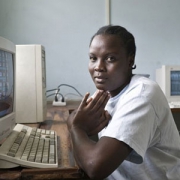5 Gender-Integrated ICT Strategies for Trade!
A 2007 publication by USAID on Gender Integration Strategies for Trade (GIST) argues that donors have developed an array of innovative programs for removing or mitigating gender-specific barriers to economic growth. Yet, moving from theory to action still remains a challenge for many program managers.
On this years International Women’s Day celebration, I would like to pick out five of these gender issues from the document for reflection.
1) Socio-Cultural Biases
Gender Issues: Are there socio-cultural biases that discourage women from entering the ICT sector?
Design and Implementation Approaches: Launch an educational campaign on the benefits of computer education and how women and girls could use the skills for a variety of careers: develop curricula on an experiential application of ICT, which studies show appeals more to girls.
Indicators: Number of people in target group trained in and adopting ICT before and after campaign, disaggregated by sex.
2) Level of Access to Market
Gender Issues: Do women and men have the same level of access to market and pricing information?
Design and Implementation Approaches: Business development service (BDS) training in ICT and other avenues for women to gain greater access to market and pricing information.
Indicators: Marketing practices adopted by enterprises as evidenced by a change in business plans, reorganization, product design, pricing, and strategic linkages with other firms or sub-sectors, disaggregated by size of enterprise and sex of owner.
3) Access to Training
Gender Issues: Do women and girls have equitable access to training at all levels, such as system design, networking, software development, content creation, web design, information management, maintenance, and system management?
Design and Implementation Approaches: Develop special ICT initiatives to train women, including those displaced from other sectors; include complementary interventions with training, such as job placement assistance, workforce development skills (hard and soft), and other ancillary services (banking for the poor, small “bridge” loan program, etc.).
Indicators: Number of displaced workers trained, disaggregated by sex; number of trained displaced workers hired for new ICT jobs, disaggregated by sex; levels of participant satisfaction with training, disaggregated by sex.
4) Affordability of Technologies
Gender Issues: Are technology choices affordable for women and men?; will technology be affordable? will prices be passed onto the consumer?; will rates be higher in rural areas where women predominate?; is there access in rural areas?
Design and Implementation Approaches: Address issues of access and affordability of ICT (e.g., fixed wireless rather than fiber optic cables, availability of mobile phones to promote connectivity in rural and poor areas, satellite or solar- and battery-powered connectivity, multiple-use computers) in project design and/or implementation; conduct gender analysis of telecommunications development fund activities to promote greater access and use of ICT for urban and rural women; conduct regulatory reform work to ensure continued affordability and accessibility of service.
Indicators: Number of users disaggregated by sex and geographical location.
Number of policy measures passed that deal with increasing affordable access to the rural poor.
5) Women’s Mobility
Gender Issues: How might women’s mobility affect their ability to access ICT?
Design and Implementation Approaches: Establish ICT access centers in rural areas and in locations in urban areas frequented by women, such as women’s bookstores, clothing stores, community centers, hair salons, or health clinics; consider establishing micro-telcos (telephone and Internet shops) as small businesses for women entrepreneurs located near health clinics, women’s stores, etc.; consider adding Internet service to existing telecenters; address women’s mobility constraints with mobile computer buses that travel to communities, or other mobile telecommunication projects, as a means of increasing women’s access to ICT.
Indicators: Number of centers established by geographical location; number and percentage of customers at telecenter, disaggregated by sex and telecenter location; change in user satisfaction of telecenters, disaggregated by sex.
The big question is how much of these do you have in your projects? Visit here for the detailed issues, design and implementation approaches and indicators.










































